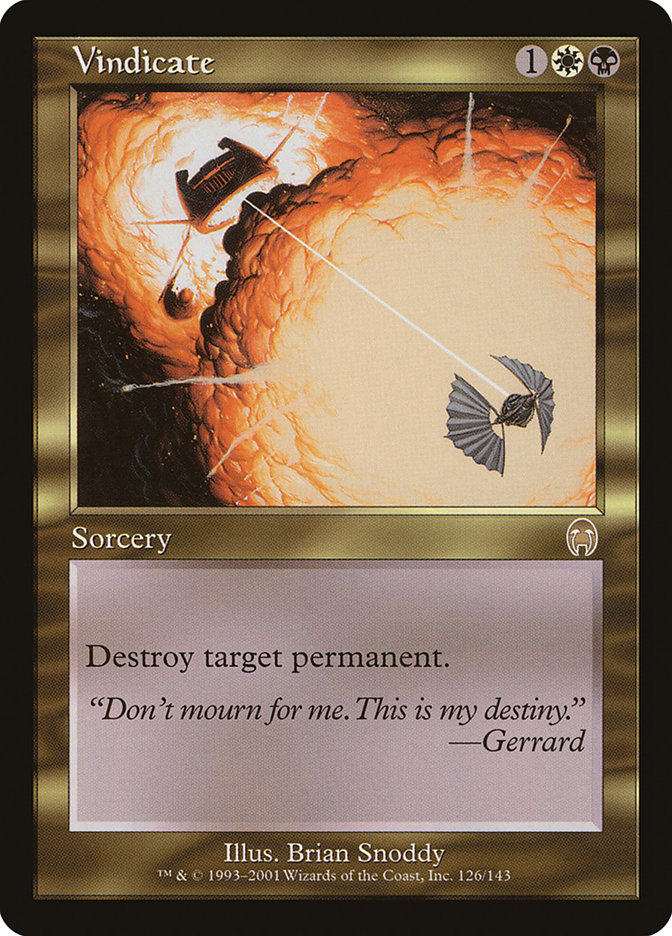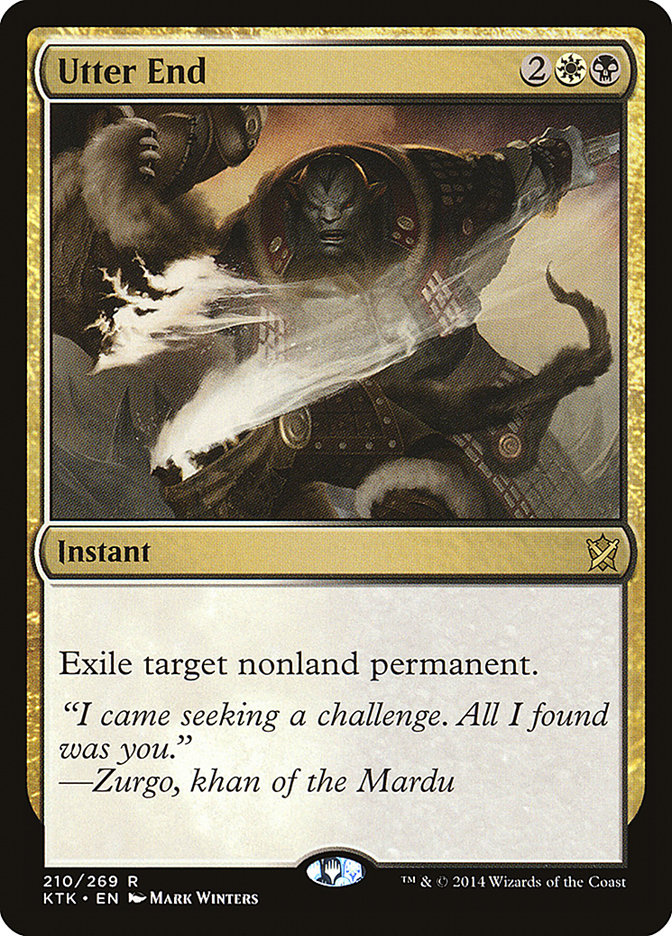Change is one of the many constants in Magic. It isn’t just like the seasons, where the sets come and go. The cycles in Magic can change their form too
-witness the recently announced change in how Standard will be played. In the current form of sets, the three-set cycle, we’re about to begin anew, with
Khans of Tarkir.
What do we know so far? We know that Sarkhan Vol is a major player in the set. We know that Khans of Tarkir will feature so-called
“enemy wedges” (two allied colors and an opposing color). Like many sets, we’ll see a combination of old abilities (Morph and Delve, to name a few), and
new (Outlast, for example).
As anyone who has known me for a while (or follows my Facebook) will tell you, when I
think about Magic, I often think about history. The past is a great shortcut to understanding the future. When I imagine what a wedge-based set might look
like, my first thoughts go to Shards of Alara Block. The allied colors would form the groups like Jund and Esper that we all came to know, and in order to
make the vicious color-requirements that three-colored spells needed to be more manageable, a ton of help was available. Hybrid mana, landcycling, and a
variety of two-colored cards within the shards meant that we could cast what we needed to. Within Khans of Tarkir, morph plays a similar role in making
life easier, as will the fetchlands.
If we go back well before Shards of Alara though, we can actually see wedges in action. In Invasion Block, the wedges showed up (with names like Ana, Raka,
and more!), amidst all kinds of multi-colored madness. By the time the full block was out, one of the most powerful decks in Invasion Block Constructed had
established itself. And while this decade-old deck doesn’t involve a wedge, it does have a lot going on with it that can inform us about what we can see
today.
Creatures (11)
Lands (26)
Spells (23)
Sideboard

While I prefer my old teammate Jacob Janoska’s build of the deck (he was defeated in the quarterfinals of this tournament), one key element to both of
their decks was this potent pair of cards:
Able to destroy nearly anything, these two cards were the backbones of this Block deck, and of the two of them, Vindicate would be a mainstay in
Constructed for as long as it was legal in the less powerful formats. When Oblivion Ring was printed, it was wildly heralded as the return of Vindicate,
even though it couldn’t take out lands. Initially there was some real skepticism about Oblivion Ring (including by yours truly), but eventually, it became
quite clear that even unstable versions of Vindicate were great, even if they couldn’t take out a Treetop Village or a Mutavault.
Even despite this, Recoil still was a card that really shared the stage well with Vindicate. Vindicate was certainly the more powerful card, but Recoil
would still get uttered in the same breath, albeit as the lesser cousin of Vindicate, and they played together incredibly well. Recoil, unlike a mere
Boomerang, didn’t actually end up costing its caster a card in the card economy count. While, unlike Vindicate, the Recoil might only be a temporary
solution, ultimately the leg up that it had on Vindicate was undeniable: being an Instant is great.
And so, when I saw the Khans of Tarkir card, Utter End, my head went back to Minneapolis, and thought of the possibilities. Here is that card:
Whenever people make comparisons to older cards, oftentimes one of the first things that happens is people look for how the card doesn’t measure
up. Vindicate was great, for example, because people could use the card as a Stone Rain against an opponent who was having mana troubles. While this line
of play would sometimes end up being a waste of a powerful resource, it is still absolutely true that Utter End is not only a touch more expensive but also
can’t be used in this way at all.
That was then, this is now.
The game changes, and the ability to have mana-stunting effects like Stone Rain seems to be a thing of the past. We live in an era where that kind of
ability isn’t really a part of the fabric of the game, and so the one small loss is not a big deal. Ultimately, what are the real ways in
which this hurts things?
We won’t know how many ways there will be in Khans of Tarkir Standard that we can get lands to attack until the full spoiler is out, but, for now, Nissa,
Worldwaker is about the only card that goes down that path. Unless it gets reprinted, Mutavault will have stopped being a card that one needs to answer.
This means that Utter End will be nearly all upside. It’s hard to say how much “cheaper” an Instant is than a Sorcery, but the flexibility of being able to
wait until the end of an opponent’s turn is huge in terms of utility. In addition, exiling a card is incredibly powerful when compared to merely destroying
it. Whether it is indestructible, regeneration, or simply a card that can find its way back from the graveyard, being able to truly and “utterly end” a
card is a big deal.
Take, for example, the gods of Theros Block. Right now, aside from Deicide, the only ways to remove a god are fragile answers like Detention Sphere and
Banishing Light. When you’re dealing with a card like Erebos, God of the Dead or Thassa, God of the Sea, waiting around for a god to finish you off isn’t
an option. After the rotation, Detention Sphere will be gone, and Banishing Light might not be a permanent solution. Deicide, as great as it is against a
god, can be hard to justify as a maindeck card except in the most particular of metagames.
Utter End can provide an answer to basically any hard-to-deal-with permanent, not be fragile, and not be a card so specialized that it is dead.
Utter End doesn’t care if you are playing against Purphoros, God of the Forge, Polokranos, World Eater, Elspeth, Sun’s Champion, Whip of Erebos, or Soul of
Innistrad. Utter End just takes care of the card completely.
What is Utter End bad against?
Well, spending four mana to take out a Firedrinker Satyr is not spectacular. However, in Black and White, there are likely going to be plenty of other
cards that you can use earlier in the game. When we think about the power of Hero’s Downfall, for example, it is understood that the extra cost in mana
over the myriad of two-mana removal spells still makes the card worth it because of its flexibility; we know that we can always play Hero’s Downfall on top of the cheaper removal. We pay the premium price on Downfall because of the added versatility. Utter End, by comparison, not only adds
versatility but raw power on top of it.
It is also not stellar against a deck with either very few non-land permanents, only shroud-based permanents (or the right colors of protection), or a deck
that commits to a token-based strategy. While any of these strategies might emerge in the new Standard, even then, Utter End still seems reasonable. In the
past, the control deck with very few non-lands still had to win some time, and a card like Utter End will be in reserve to take care of the
trouble. Cards with shroud tend to need some support cards to really be problematic, and again, Utter End can help wrap things up. Even in these scenarios,
for the most part, Utter End is still solid even if it isn’t exemplary.
What is Utter End good against?
If decks are playing permanents that cost four or more mana, Utter End is going to be a good card against them. You can be waiting, untapped, with 2WB, and
just know that your opponent won’t have many cards at all that you can’t just answer. Looking at the way I imagine Standard playing out, I expect that
means the answer to “What is Utter End good against?” is “almost everything”.
Sitting untapped, if your opponent doesn’t force you to cast the card, this also means that you can do something else. While 2WB is already a two-color
investment, I won’t be surprised to see a turn 5 or 6 where Utter End is at the ready, and when nothing important happens, Jace’s Ingenuity gets cast
instead, pushing that player ahead even further.
White is traditionally a color that is pretty good at answering the obscure permanents. Black is traditionally a color that is great at answering
creatures. Now, with Utter End, we have a return to the days of Vindicate, where White/Black players can have a catch-all answer. Whether alone or paired
with Blue, Red, or Green, Utter End is going to be a mainstay in Standard for a long time to come.



